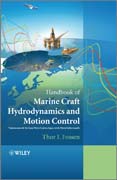
Handbook of marine craft hydrodynamics and motion control: vademecum de navium motu contra aquas et de motu gubernando
Fossen, Thor I.
This book includes methods for the design and implementation of industrial guidance, navigation and control (GNC) systems for ships, high-speed craft, semi-submersibles, submarines, underwater vehicles and ocean structures. To be able to design motion control systems it is evident that a good mathematical model of the craft and the environment (wind, waves and ocean currents) are required for simulation and verification of the design. The mathematical models are derived in a vectorial setting using Lagrangian and Newtonian mechanics. Simulation models based on the two main theories - maneuvering and seakeeping - are presented, and the concept of fluid-memory effects are demystified. This text covers state-of-the-art methods for GNC, including nonlinear multivariable PID controllers, state estimators and control allocation methods. More advancedtopics, such as optimal control theory, backstepping, feedback linearization and sliding-mode control, are included for the advanced reader. Case studies and applications are treated at the end of each chapter. The Marine Systems Simulator (MSS), which is an open source Matlab toolbox, is used for illustration. INDICE: Preface Tables I Marine Craft Hydrodynamics 1 Introduction 1.1 Classification of Models 1.2 The Classical Models in Naval Architecture 1.3 Fossen's Robot-Like Vectorial Model for Marine Craft 2 Kinematics 2.1 Reference Frames 2.2 Transformations between BODY and NED 2.3 Transformations between ECEF and NED 2.4 Transformations between BODY and FLOW 3 Rigid-Body Kinetics 3.1 Newton-Euler Equations of Motion about CG 3.2 Newton-Euler Equations of Motion about CO3.3 Rigid-Body Equations of Motion 4 Hydrostatics 4.1 Restoring Forces for Underwater Vehicles 4.2 Restoring Forces for Surface Vessels 4.3 Load Conditions and Natural Periods 4.4 Ballast Systems 5 Seakeeping Theory 5.1 Hydrodynamic Concepts and Potential Theory5.2 Seakeeping and Maneuvering Kinematics5.3 The Classical Frequency-Domain Model 5.4 Time-Domain Models including Fluid Memory Effects 5.5 Case Study: Identification of Fluid Memory Effects 6 Maneuvering Theory 6.1 Rigid-Body Kinetics 6.2 Potential Coefficients 6.3 Nonlinear Coriolis Forces due to Added Mass in a Rotating Coordinate System 6.4 Viscous Damping and Ocean Current Forces6.5 Maneuvering Equations 7 Models for Ships, Offshore Structures and Underwater Vehicles 7.1 Maneuvering Models (3 DOF) 7.2Autopilot Models for Heading Control (1 DOF) 7.3 DP Models (3 DOF) 7.4 Maneuvering Models including Roll (4 DOF)7.5 Equations of Motion (6 DOF) 8 Environmental Forces and Moments 8.1 Wind Forces and Moments 8.2 Wave Forces and Moments 8.3 Ocean Current Forces and Moments II Motion Control 9 Introduction 9.1 Historical Remarks 9.2 The Principles of Guidance, Navigation and Control 9.3 Setpoint Regulation,Trajectory-Tracking and Path-Following Control 9.4 Control of Underactuated and Fully Actuated Craft 10 Guidance Systems 10.1 Target Tracking10.2 Trajectory Tracking 10.3 LOS Path Following for Nonparametrized Paths10.4 Curved-Path Path Following for Parametrized Paths 11 Sensor and NavigationSystems 11.1 Low-Pass and Notch Filtering 11.2 Fixed Gain Observer Design 11.3 Kalman Filter Design11.4 Nonlinear Passive Observer Designs 11.5 IntegrationFilters for IMU and Global Navigation Satellite Systems 12 Motion Control Systems 12.1 Open-Loop Stability and Maneuverability 12.2 PID Control and Acceleration Feedback 12.3 Control Allocation 13 Advanced Motion Control Systems 13.1Linear-Quadratic Optimal Control 13.2 State Feedback Linearization 13.3 Integrator Backstepping 13.4 Sliding-Mode Control Appendices A Nonlinear Stability Theory A.1 Lyapunov Stability for Autonomous Systems A.1.1 Stability and Convergence A.1.2 Lyapunov's Direct Method A.1.3 Krasovskii-LaSalle's TheoremA.1.4 Global Exponential Stability A.2 Lyapunov Stability of Nonautonomous Systems A.2.1 Barbalat's Lemma A.2.2 LaSalle-Yoshizawa's TheoremA.2.3 Matrosov's Theorem A.2.4 UGAS when Backstepping with Integral Action B Numerical Methods B.1 Discretization of Continuous-Time SystemsB.1.1 Linear State-Space Models B.1.2 Nonlinear
- ISBN: 978-1-119-99149-6
- Editorial: John Wiley & Sons
- Encuadernacion: Cartoné
- Páginas: 575
- Fecha Publicación: 15/04/2011
- Nº Volúmenes: 1
- Idioma: Inglés
